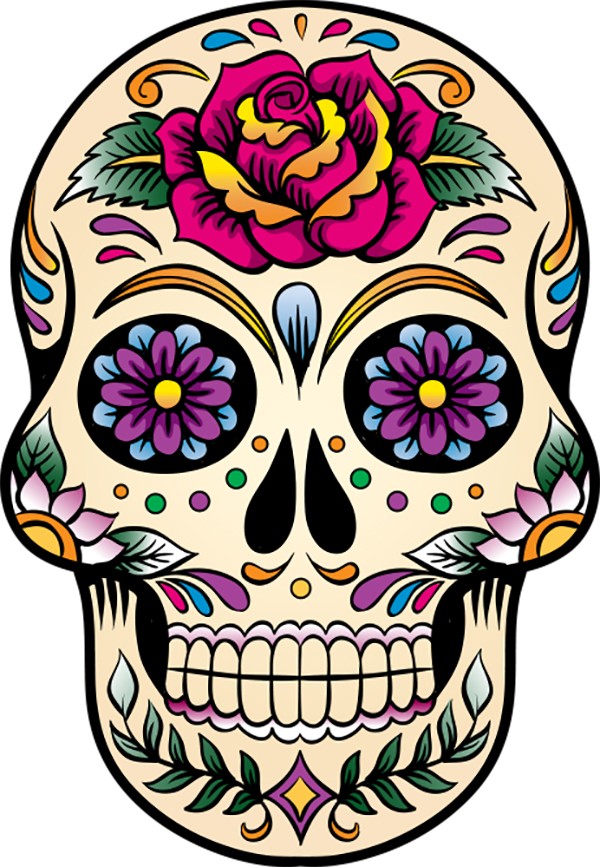My first memories of Día de los Muertos are of the long hallways of an elementary school over on Winchester Road. I was 12, and having never witnessed a Day of the Dead celebration of any sort before, I took my time walking down the hallways of the school. With a book in my hand, I walked and found myself stopping at each altar and studying them. There was so much information to take in all at once. I didn’t open up my book much that day.
Altars were placed up and down the hallway on tables and the floor. The ones on the floor rose high above the ground because of the tiers that were shaped by a mix of large and small cardboard boxes and covered by cloth. Pan de muerto, sweet rolls of bread topped with sugar, sat next to collections of candy and bowls of fruit. While the types of food differed between each altar, they each had unlit wax candles or those small battery-operated candles that you find in the dollar store.
As I walked further down the hallway, I looked at each framed photo that appeared to have come from family photo albums. Some altars had images that I could recognize like famous musicians, artists, and actors. Others were prepared by organizations, and instead of having individual photos of people, they would have ofrendas that represented images of people. One table had materials that symbolized construction workers with bright orange vests, hardhats, and work boots. This altar remembered the lives of workers who died while working in construction due to unsafe work conditions.
 Krookedeye | Dreamstime.com
Krookedeye | Dreamstime.com
Further down the hallway into the main lobby of the school I saw an altar by Danza Azteca Quetzalcoatl, one of the Aztec dance groups in the city. Like the other altars, it had multicolor papel picado, breads, food, and candles. It lay on the ground with incense bowls and was much larger than all other altars in the hallway. Cempazúchitl (marigold) flowers painted the white tile floors in a sea of yellow and orange.
I later learned some of the different elements and significance of Día de los Muertos. The celebration pulls aspects from Catholic Church rituals and pre-Columbian religious traditions going as far back as 3,000 years. The Aztec deity Mictecacíhuatl, or Lady of the Dead, is the protector of the dead and is more commonly referred to as La Catrina, whose image was popularized by Mexican printmaker José Guadalupe Posada. Traditionally, the dead were honored during the month of August. Along with music and processions, altars celebrated their life with the favorite food and drink of deceased. The month of celebration was condensed to November 1st and 2nd, All Saints Day and All Souls Day, with the arrival of Spanish missionaries who, realizing a resistance in the forceful converting of Native people to Christianity, could not do away with all aspects of indigenous culture and tradition.
Today, across cities and regions in the U.S. and Mexico, the traditions of Día de los Muertos take on various interpretations. Since walking down the halls of that elementary school many years ago, my understanding of Día de los Muertos has grown along with the reach of these celebrations across Memphis. This year, there are at least four public Día de los Muertos events around our city organized by or in partnership with Mexican and Latinx people and organizations. The Memphis Day of the Dead that was once held at an elementary school and other venues will now be held for the second year at El Mercadito on Ridgeway on November 4th (1p.m.-7p.m.).
Because I didn’t grow up celebrating Día de los Muertos in my home, it took a few years of listening and observing to learn, and I continue to learn each year. Día de los Muertos has taught me to value not only the people in our life but also to honor those who have passed on from our life — to value and celebrate what they have taught us and what they continue to teach us beyond their own lived years. The lives de los muertos, the lives of the dead, that we remember on these two days in November and beyond teach us how to love and that we should extend that love to everyone. We extend that love to our folks like the TPS Journey for Justice Caravan that visited our city. We welcome you. We extend that love to the caravan of the south, the caravan of refugees from Central America who, like many before them, are seeking asylum in Mexico and the U.S. To the people walking hundreds of miles on foot with their children and to those walking alone, we welcome you.
And following Día de los Muertos, we recognize where we have failed at the lessons of love and growing taught to us by Día de los Muertos, among its many lessons.
Of utmost importance this Día de los Muertos, we must remember all those folks who were not welcomed and loved, those who were not given the chance to live their life to the fullest and to teach and grow with us. To Roxana Hernandez, a transgender woman and asylum seeker from Honduras who died in ICE custody, one of nine people to die in ICE custody this year … we failed you. And, in the spirit of this beautiful holiday, we will hold your name and your life with us, remembering your legacy, recognizing that we need to do better. Who will you remember to honor this Día de los Muertos?
Aylen Mercado is a brown, queer, Latinx chingona and Memphian pursuing an Urban Studies and Latin American and Latinx Studies degree at Rhodes College.

 Krookedeye | Dreamstime.com
Krookedeye | Dreamstime.com